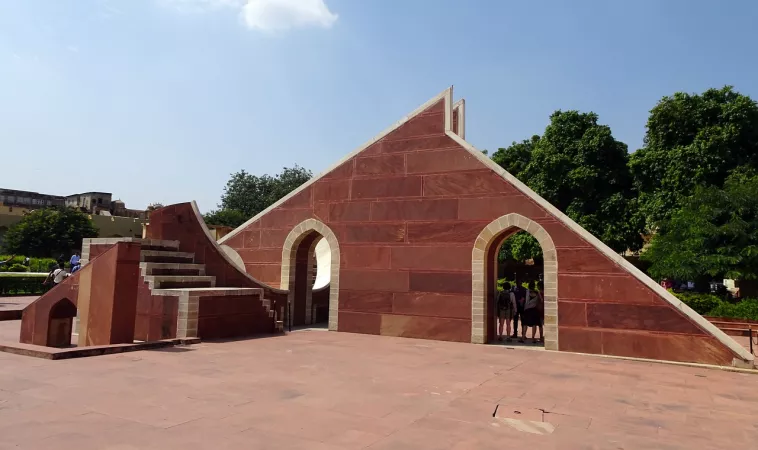
Jantar Mantar
Duration
1 to 2 Days
1 to 2 Days
Best time to visit
Oct-Mar
Oct-Mar
Theme
Heritage
Heritage
Jantar Mantar Travel Guide
Jantar Mantar, located in Jaipur, India, is a UNESCO World Heritage Site known for its collection of architectural astronomical instruments. Built in the 18th century, it showcases the scientific and technological advancements of the time. The site holds historical significance and offers a glimpse into India's rich cultural heritage.Top Attractions in Jantar Mantar
- The Samrat Yantra
- The Jai Prakash Yantra
- The Ram Yantra
- The Misra Yantra
Jantar Mantar is Famous for
Architectural astronomical instrumentsTop Attractions in Jantar Mantar
- Experience the Samrat Yantra, the largest sundial in the world
- Marvel at the Jai Prakash Yantra, an instrument used to measure the position of the sun and stars
- Explore the Ram Yantra, a set of two large structures used for measuring altitudes and azimuths
- Visit the Misra Yantra, a unique instrument that combines multiple functions
What's Great about Travelling to Jantar Mantar?
- Perfect for history buffs and architecture enthusiasts
- Offers a unique cultural experience
- Ideal for those interested in astronomy and science
What's Not So Great about Travelling to Jantar Mantar?
- May not be suitable for travelers looking for modern attractions
- Limited dining and accommodation options nearby
- Not recommended for those with mobility issues due to uneven surfaces
Travel Tips for Jantar Mantar
- Check the opening hours and plan your visit accordingly
- Wear comfortable shoes as you will be walking on uneven surfaces
- Respect the historical significance of the site and follow all rules and regulations
Important Jantar Mantar trip information
- Ideal Duration: Half a day
- Best Time to Visit: Early morning or late afternoon
- Nearby Airports and Railway Stations: Jaipur International Airport and Jaipur Railway Station
FAQ's on Jantar Mantar
Q1: What is the best time to visit Jantar Mantar?
The best time to visit Jantar Mantar is during the winter months from October to March when the weather is pleasant and ideal for exploring outdoor attractions. This period also coincides with various festivals and events in the region, offering a vibrant cultural experience for visitors. It is advisable to avoid the summer months due to the scorching heat in Jantar Mantar.
Q2: Do I need a visa to travel to Jantar Mantar?
Visitors to Jantar Mantar typically do not require a visa as it is a historical site located in India. However, if you are traveling from another country, it is essential to check the visa requirements based on your nationality. Ensure that your travel documents are in order before planning your trip to Jantar Mantar.
Q3: What are the must-visit attractions in Jantar Mantar?
Some of the must-visit attractions in Jantar Mantar include the iconic astronomical instruments like the Samrat Yantra, Jai Prakash Yantra, and Ram Yantra. Exploring these ancient instruments offers a unique insight into the astronomical knowledge of the past. Additionally, the nearby attractions like City Palace, Hawa Mahal, and Amber Fort are worth visiting to experience the rich history and culture of Rajasthan.
Q4: Is Jantar Mantar a safe place to travel?
Jantar Mantar is generally a safe place for tourists to visit. However, like any other tourist destination, it is essential to remain cautious of pickpocketing and follow basic safety precautions. Avoid isolated areas at night and be mindful of your belongings. It is recommended to travel with a reputable tour guide or group for a more secure experience.
Q5: What is the local currency in Jantar Mantar and can I use credit cards?
The local currency in Jantar Mantar is the Indian Rupee (INR). While credit cards are widely accepted in hotels, restaurants, and larger shops, it is advisable to carry some cash for smaller vendors and local markets. ATMs are also available in the vicinity for convenient access to cash during your visit.
Q6: What is the local cuisine like in Jantar Mantar?
The local cuisine in Jantar Mantar, influenced by Rajasthani flavors, offers a diverse range of dishes rich in spices and flavors. Must-try dishes include Dal Baati Churma, Gatte ki Sabzi, and Laal Maas. Vegetarian options like Ker Sangri and Mawa Kachori are also popular. Food enthusiasts can explore the bustling markets for street food delights like Pyaaz Kachori and Mirchi Bada, showcasing the vibrant culinary scene of Jantar Mantar.
Q7: What transportation options are available in Jantar Mantar?
Transportation options in Jantar Mantar include public buses, auto-rickshaws, and taxis for convenient travel within the city. Tourists can also opt for app-based cab services for hassle-free commuting. Renting a car or hiring a private driver is another popular choice for exploring nearby attractions at your own pace. Additionally, cycle rickshaws and horse-drawn carriages offer a unique and traditional mode of transportation in certain areas of Jantar Mantar.
Q8: Are there any cultural norms or etiquette I should be aware of when visiting Jantar Mantar?
When visiting Jantar Mantar, it is important to respect the local customs and traditions of Rajasthan. Dress modestly, especially when visiting religious sites, and remove your shoes before entering temples or homes. Greeting people with a "Namaste" and showing courtesy towards elders are appreciated gestures. Avoid public displays of affection and be mindful of local sensitivities. When dining, it is polite to eat with your right hand and accept food or drink with both hands. By being respectful of the culture and customs, you can have a more enriching experience during your visit to Jantar Mantar.
Q9: I am a travel agent. How can I buy travel leads of Jantar Mantar?
Register yourself as a travel agent at agents.tripclap.com and then you can buy travel leads to Jantar Mantar once your account is approved. For more details contact our support team at +91-8069186564 or support@tripclap.com
